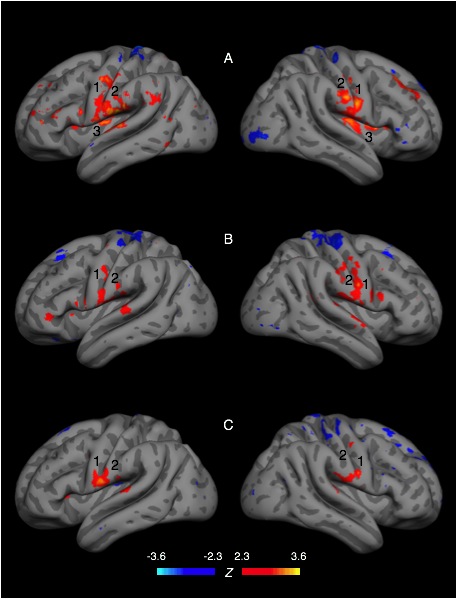ABSTRACT: 0167
Functional MRI of oropharyngeal air-pulse stimulation
| P. SÍRÍS, E. LALONE, R.C. SMITH, T.K. STEVENS, J.A. THEURER, R.S. MENON, and R.E. MARTIN, University of Western Ontario, London, Canada | |
Objectives: While the peripheral and brainstem innervation of the oropharynx have been investigated, the extent to which the oropharynx is represented within central cortical and subcortical structures remains poorly understood. The aim of the present study was to investigate the central processing of oropharyngeal air-pulse stimulation with functional magnetic resonance imaging (fMRI). Methods: Participants were 6 right-handed healthy females (age: 21 - 45 years). FMRI at 4 Tesla was performed during air-pulse stimulation of the left, right, and bilateral oropharynx. For each condition, 6 blocks of 20 air pulses over 10 s were delivered through a custom-made lower dental splint and directed toward the peritonsillar region of the lateral oropharynx. Results: The figure summarizes the results of the group analysis for bilateral (A), left (B), and right (C) stimulation. Bilateral stimulation resulted in activation of the lateral pre- (1) and postcentral gyrus (2), insula (3), supplementary motor area, anterior cingulate cortex, and right thalamus (not shown). Left and right stimulation activated the bilateral pericentral cortex, with predominance of the contralateral hemisphere. Conclusion: This study suggests that air-pulse trains delivered to the oropharynx activate a widely distributed network of cortical and subcortical areas. This network includes not only core areas of the somatosensory, but also of the motor system (primary motor cortex, supplementary motor area, cingulate motor areas). These findings (a) may explain the previously observed facilitation of swallowing by air-pulse stimulation (Theurer et al. Dysphagia 2005) and (b) suggest that the air-pulse stimulation technique provides a valuable method for investigating the central representation of the oropharynx. Funding: Heart and Stroke Foundation of Ontario (REM), Ontario Ministry of Health and Long-Term Care Salary Support (REM), Premier's Research Excellence Award (REM), Canada Research Chair Support (RSM), and Canadian Institutes of Health Research Maintenance Grant (RSM).
| |
| Seq #38 - Keynote Address and Thirty Years of Orofacial Pain Research 9:00 AM-10:30 AM, Thursday, July 3, 2008 Metro Toronto Convention Centre Room 714A | |
©Copyright 2008 American Association for Dental Research. All Rights Reserved.
